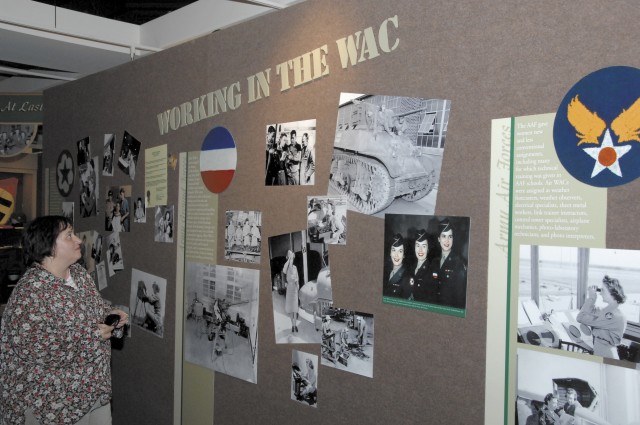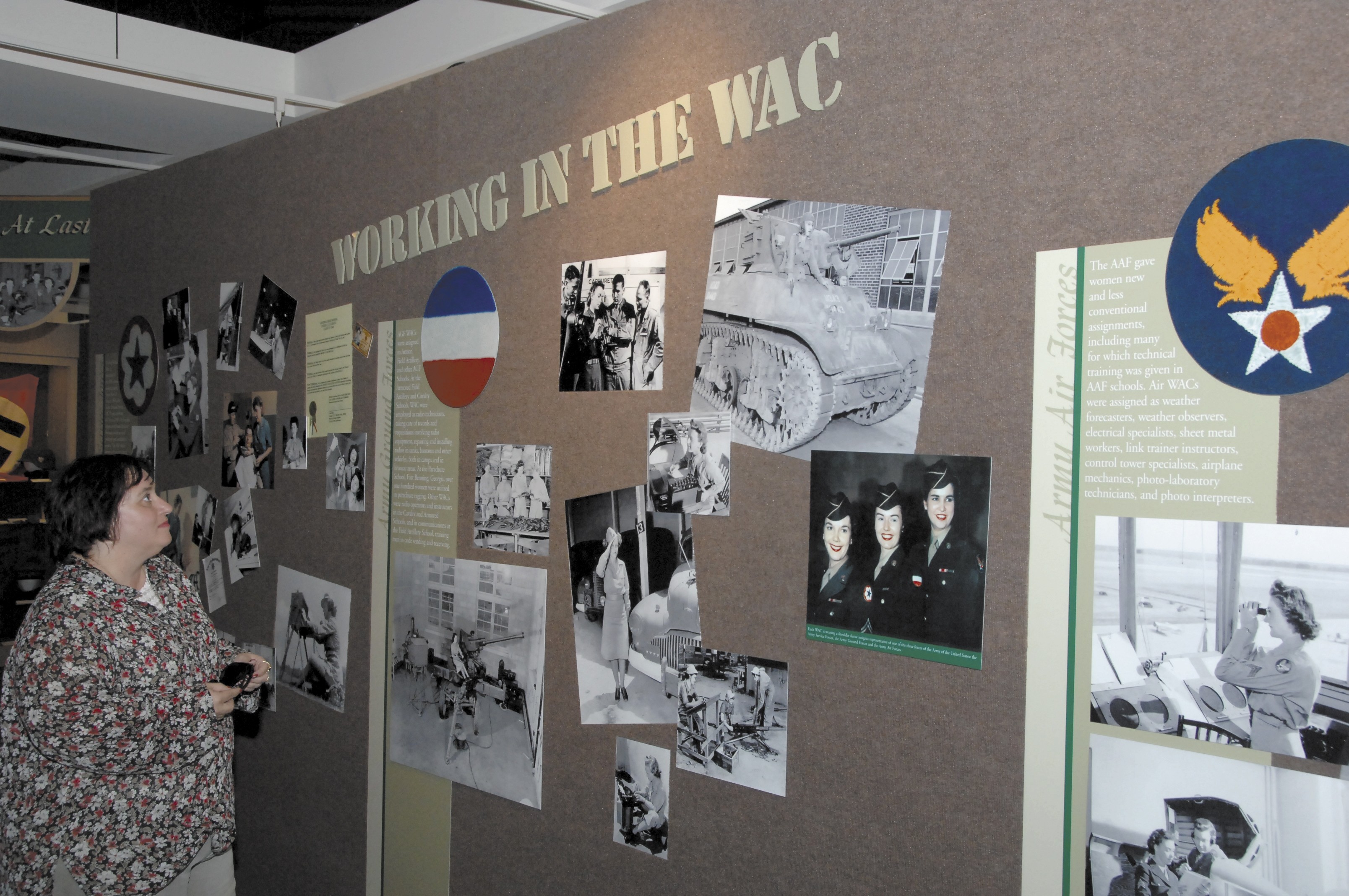
Fort Lee, Va. (Aug. 20, 2008) -- In August 1975, a headstrong 19-year-old woman in Washington State chose to break free from her family's mold. Without her parents' approval, she decided on a delayed entry into the Women's Army Corps.
"I joined the Women's Army Corps not to become a wife," said Debbie Kilpatrick, an environmental protection specialist on Fort Lee. "Every woman in my family had gotten pregnant by 17 and was raising children, and I craved the excitement of the big world. I snuck off and joined the WAC without either one of my parents knowing."
She delayed telling her father, as he made it clear he did not want a daughter joining the service.
"I was heartbroken and I cried," she said. "I wanted my dad to be proud, but he was against it. I said 'Sorry, I have to go, I already enlisted.'"
On Jan. 13, 1976, Kilpatrick was shipped off to Fort Jackson, S.C., for WAC training. After spending two weeks there, her company was transported to Fort McClellan, Ala., for a surprise none of the women suspected.
"They had all of these gals in a room, and they are telling us we're not going to be WACs," Kilpatrick said. "You could hear a pin drop, and we were thinking we're all going to be sent home. They don't need us or want us."
But that wasn't quite the case.
"They said you're going to join the U.S. Army," she continued. "They brought in a WAC colonel and she said 'I want you to think about this before you raise your hand.' There was this wonderful moment when she said 'You're going to become part of the largest social experiment for women in history. This has never been done, and you will be representing all women. If you fail, you're all going to be cooks and secretaries for the rest of your life; you're never going to get out of that. You can't fail.'"
Given the option of opting out of the Army at that point, 500 young women sat in that room and not a single one walked out, Kilpatrick said. There was a small ceremony conducted to signify the change.
"Even as we were pulling off our Pallas Athene (WAC collar brass) to replace them with the U.S. collar brass, we knew we were in a moment," she said. "There were tears from the older cadre as it happened."
In the WAC, all women were trained by women, but Kilpatrick's group was quickly introduced to their new drill sergeant.
"He was a green beret who had broken his leg jumping out of a helicopter, and was in recovery," she said. "Basically, for his punishment, he was being sent off to train women to be in the 'Man's Army.' He was the most unpleasant individual in the world. He was hurt, his pride, his dignity; and now he was being forced to train women. He was not sold on the idea that we could even do it; he was critical from the very beginning, and he didn't think we could even do it."
At the time, there were no standards in the U.S. Army for the physical fitness for women, and they were expected to meet the standards of the men.
"The physical training was a huge shock to us," Kilpatrick said. "Some of the gals had never walked further than from a car to anywhere. Suddenly, we were training to reach a standard that was set for men. We failed badly on many aspects of the training. The physical fitness training was the hugest hurdle for us. How we got through it - we helped each other."
The women had to band together in order to ensure everyone passed all of the seemingly insurmountable requirements of the training.
"I had a limitation, I'm five feet tall, and I had to jump a five-foot ditch as part of my physical training," she said. "In my mind, I couldn't do that. Two of the girls I was with that were very athletic took a Saturday afternoon to teach me how to jump this ditch. I stumbled and fell. I tore my fatigues. These two gals made sure that I could do that before we were done. We did that for each other. None of us would let the others fail."
At Kilpatrick's advanced individual training in Redstone Arsenal, Ala., it was determined that she would be a nuclear storage and handling specialist. She was also promoted to E-2. It was also the first time she was trained with men.
"Oddly enough, I ended up being the senior person in the class that had Marines," she said. "I had to march Marines. That was my first contact with being with a man in a marching formation. With women, we had a shorter stride; we didn't work the big steps. I was there with these Marines, and I couldn't keep up with these guys, and I was marching them. I had to put them at half-step. They would get leg cramps by the little girl marching them. And if leg cramps were not bad enough to endure, they got teased horribly, these big macho Marines."
Making it through AIT, Kilpatrick got her first assignment with the 8th Ordnance on Fort Bragg, N.C., as the first female assigned to the ammunition supply point. Upon arrival, the first hurdle was finding her a uniform.
"There was this huge discussion, through the upper levels of Fort Bragg, on whether I would wear my shirt tail in or out," she said. "If I wore the shirt tail in, I was showing too much fanny, but if I didn't wear my shirt tail in, I wouldn't look like the rest of the Soldiers. I wore my shirt tail out, because they decided that having my fanny sticking out was more of a problem."
Kilpatrick was required to wear her skirt while in her company, and could only wear her fatigues in her work environment. She carried extra clothes with her constantly to ensure she would be in the proper uniform in the proper areas.
Her first sergeant in Fort Bragg was extremely unhappy he was assigned a female, which he made perfectly clear her first morning in formation.
"He called me out in front of the formation, and told me to get out of this man's Army," Kilpatrick said. "'Go home, and make babies.' I told him 'Sergeant, this private's here to stay, Sergeant.' You could tell he was not expecting that answer."
Every formation for three months, her first sergeant called her to the front and told her to go home and make babies. Kilpatrick's response every day was "Sergeant, this private's here to stay, Sergeant."
Kilpatrick, whose maiden name is James, would soon receive an unexpected nickname.
"I knew I had finally broken the core when he started calling me 'my girl Jimmy.' 'My girl Jimmy' was as close as he could get to admitting he had a female that he could accept in his unit. That was the moment I knew I was in the Army."
A common theme throughout her military service, the U.S. Army was not prepared for her arrival in Okinawa, Japan, in December 1977.
"When I landed in Okinawa, I was met by a young man who saw me and said 'you're a girl,'" Kilpatrick said. "My last name (James) must have fooled him, and he thought he was coming for a guy."
He told her the company wouldn't know what to do with her, and Kilpatrick felt like it was Fort Bragg all over again. Most of the personnel were on vacation in late 1977, so she had to wait until January 1978 before they figured out what to do with her.
"They brought me to Warrant Officer Jones, and he asked 'Do you file','" she said. "I said no, knowing that any answer besides that was going to be a long experience for me there. He said 'Do you know how to play pinochle'" I said no. He said 'You're going to learn to play pinochle. I might not be able to teach you filing, but you're going to learn pinochle.' I was replacing the fourth at their lunch table. That's how I earned my way in at my new duty station, by learning pinochle and not knowing how to file."
In October 1978, Kilpatrick was sent to Fort Stewart, Ga., for her outprocessing.
"There was a lot of talk to try to get me to reenlist," she said. "I had completed a wild and wacky three and a half years, from beginning to end, and it was time to get out. Back then, you couldn't have babies, there was no such thing as maternity uniforms. I was ready to move to the next stage of life."
Kilpatrick has worked on Fort Lee for three years, where she deals with the major project construction work and any environmental issues on the installation. In reference to the young women in the Army today, she feels a disconnection with history.
"I mourn the fact the young women don't understand what we early transitional women did for them," she said. "We were making sacrifices to be a woman and in the military. We learned quickly how to do both. We weren't interested in being one of the boys; we were interested in doing the job. The boys weren't our friends. But we as girls were each other's friends, and we all gave our support to each other. We were going to get ourselves to the next level as a unit, not individuals."
Kilpatrick wants young women to look back to the transition of the WAC into the U.S. Army and to be proud.
"When they see us, the transitional women, they need to understand that if we had failed, the jobs that they have today in the military would not exist at all," she said. "More than that, you wouldn't have female CEOs of companies, or any women in leadership roles. They would not be there if we had failed.
"I don't want them to ever take it for granted, what any woman can do, or even more important, what any group of women can do. Never take it for granted."

Social Sharing